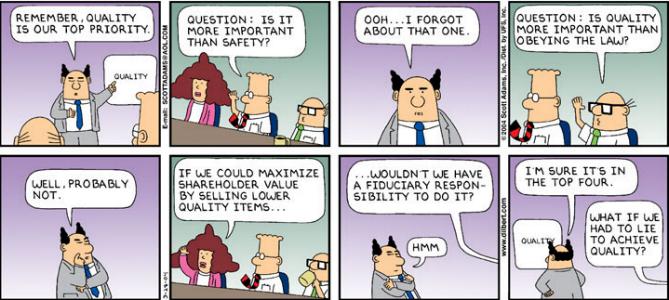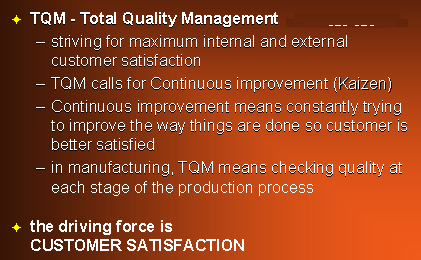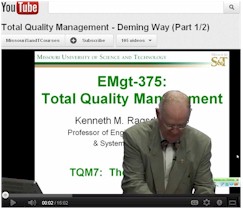Total Quality Management
- recalls

| TQM
Total Quality Management - recalls |
 |
for the students in Marketing,
Business and International Business courses taught by Prof. Tim Richardson
last updated 2014
March 28
 |
This web page has audio clips - just click on the icon (like the one to the left) and you can hear Prof. Richardson's voice adding additional information to topics on the page. |  |
turn on your speakers to hear audio clips |
| INTRODUCTION | In the 1980's
and early 1990's, when many large Japanese companies set up manufacturing
operations in North America they suffered from a competitive environment
that caused people to think that North American goods were better in quality
than Japanese goods. To address this public perception, Japanese companies
sought manufacturing methods to produce goods with a very high level of
quality so they could penetrate the market.
TQM was not invented in Japan, it was invented in the U.S., but it was used by the Japanese very effectively in the 1980's and the term has subsequently become associated with Japanese management principles. WTGR |
 |
When TQM is NOT followed
diligently, companies may be in the position to "recall" their products.
Watch Prof. Richardson's
interview w CTV news about a recall by Ford and the associated issues
http://www.ctvnews.ca/autos/
|
 |
A 1 min 27 sec intro to
TQM by Seneca student Graham H. in March 2012
Graham's example is interestingly done in the context of improving his appearance for a job interview |
.
Dilbert ©
by Scott Adams www.dilbert.com
 |
North American companies
in the late 1980's and early 1990's got the marketing equivalent of a kick
in the face from Japanese companies bringing in consumer products that
were low prices AND high quality.
U.S. companies sought to learn how Japanese did the TQM stuff - which is funny, cause the Japanese learned it from an American, Edwards Demming !
|
 |
15 minute intro to Demming
by
Prof. Kenneth Ragsdell youtube.com/watch?v=mLRnqC69c9Q&feature=related for his Engineering Management 375 course for the Missouri University of Science and Technology |
| TQM
TQM
TQM
TQM
TQM
TQM
TQM |
..... | Demming's
14 Point Plan for TQM
formerly at http://www.educe.dabsol.co.uk/Quality/Q_Demming.htm (listed, and expanded upon by Mr. Dave Wilson)
|
| TQM
|
.... | The history of how Japanese
came to be the evangelists of TQM - and how the Americans tried to catch
up
http://www.acq.osd.mil/io/se/quality/asqc_3-99.htm " During the mid 1980s, U.S. producers who complacently held the market share for so long after World War II were now starting to lose market share to the Japanese. After World War II, the Japanese had embraced statistical quality control, taught to them by American lecturers including Dr. Demming and others who had been invited to Japan, to help them convert from military to commercial production and reverse the reputation of poor quality goods." "TQM has been offered as the reason for the success of Japanese business by many observers, and Japanese versions of TQM have been shipped back not only to the US and the Americas, but also Europe. Following massive Japanese investment in other countries such as Thailand, and Singapore saw TQM become popular expecially in those countries where Japanese investment was substantial. Japanese management expertise often came accompanied with TQM, and it also offered a way to manage diverse business systems and investments for the Japanese owners. However implementation has not always been successful..." http://www.apmforum.com/emerald/tqm-asia-research.htm |
| TQM
|
.... | An interesting rant about
how, to some, TQM is bad for North Americans
http://www.freerepublic.com/forum/a39baeaf4090c.htm "TQM was the brainchild of
the late W. Edwards Deming; it supposedly helped Japan with its postwar
economic recovery. But perhaps that was because it meshed with Japanese
culture. It does not follow that TQM is a good fit for organizing America...."Quality"
sounds like goodness, pure and simple. But with TQM, quality is not the
product but the process. To institute the process, corporate trainers must
bring about a "total cultural change," wherein all
|
| TQM | Tim Richardson - 1998
speech
"TQM worked well in a homogenous culture such as Japan, but the challenge to apply TQM in North America is a multi-cultural workforce and a high Individualism Index..." TQM was considered, by the Americans in the mid 1990's, so important to understand, and try to apply to keep up with the Japanese, that they even taught the concept in the U.S. military. check Naval War College Notes:
|
|
|
CONTACT I MAIN PAGE I NEWS GALLERY I E-BIZ SHORTCUTS I INT'L BIZ SHORTCUTS I MKTG&BUSINESS SHORTCUTS I TEACHING SCHEDULE |
| . | |
| MISTAKES ITEXTS USED I IMAGES I RANK IDISCLAIMER I STUDENT CONTRIBUTORS I FORMER STUDENTS I | |
| . |